2010 FORD SUPER DUTY ESP
[x] Cancel search: ESPPage 3 of 104
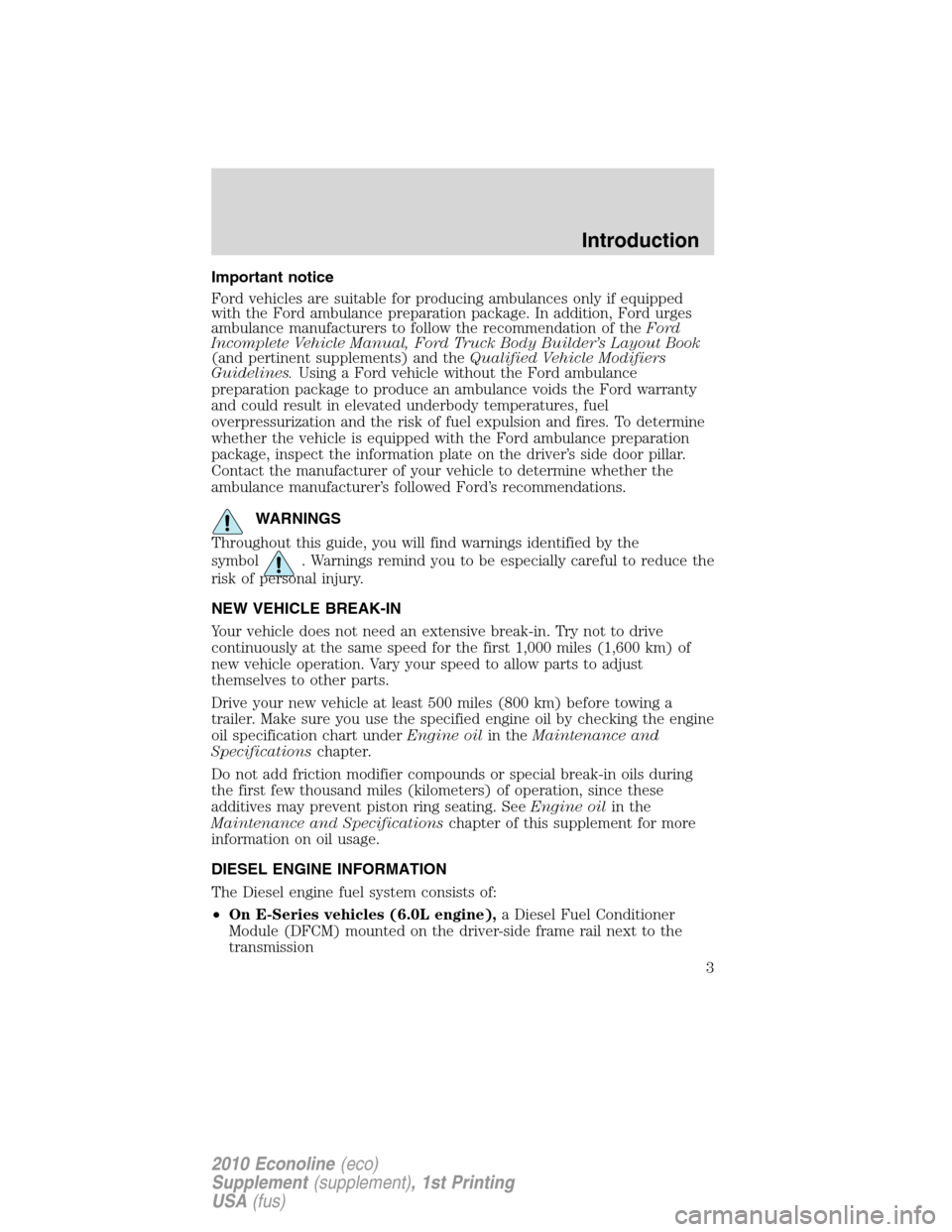
Important notice
Ford vehicles are suitable for producing ambulances only if equipped
with the Ford ambulance preparation package. In addition, Ford urges
ambulance manufacturers to follow the recommendation of theFord
Incomplete Vehicle Manual, Ford Truck Body Builder’s Layout Book
(and pertinent supplements) and theQualified Vehicle Modifiers
Guidelines.Using a Ford vehicle without the Ford ambulance
preparation package to produce an ambulance voids the Ford warranty
and could result in elevated underbody temperatures, fuel
overpressurization and the risk of fuel expulsion and fires. To determine
whether the vehicle is equipped with the Ford ambulance preparation
package, inspect the information plate on the driver’s side door pillar.
Contact the manufacturer of your vehicle to determine whether the
ambulance manufacturer’s followed Ford’s recommendations.
WARNINGS
Throughout this guide, you will find warnings identified by the
symbol
. Warnings remind you to be especially careful to reduce the
risk of personal injury.
NEW VEHICLE BREAK-IN
Your vehicle does not need an extensive break-in. Try not to drive
continuously at the same speed for the first 1,000 miles (1,600 km) of
new vehicle operation. Vary your speed to allow parts to adjust
themselves to other parts.
Drive your new vehicle at least 500 miles (800 km) before towing a
trailer. Make sure you use the specified engine oil by checking the engine
oil specification chart underEngine oilin theMaintenance and
Specificationschapter.
Do not add friction modifier compounds or special break-in oils during
the first few thousand miles (kilometers) of operation, since these
additives may prevent piston ring seating. SeeEngine oilin the
Maintenance and Specificationschapter of this supplement for more
information on oil usage.
DIESEL ENGINE INFORMATION
The Diesel engine fuel system consists of:
•On E-Series vehicles (6.0L engine),a Diesel Fuel Conditioner
Module (DFCM) mounted on the driver-side frame rail next to the
transmission
Introduction
3
2010 Econoline(eco)
Supplement(supplement), 1st Printing
USA(fus)
Page 13 of 104
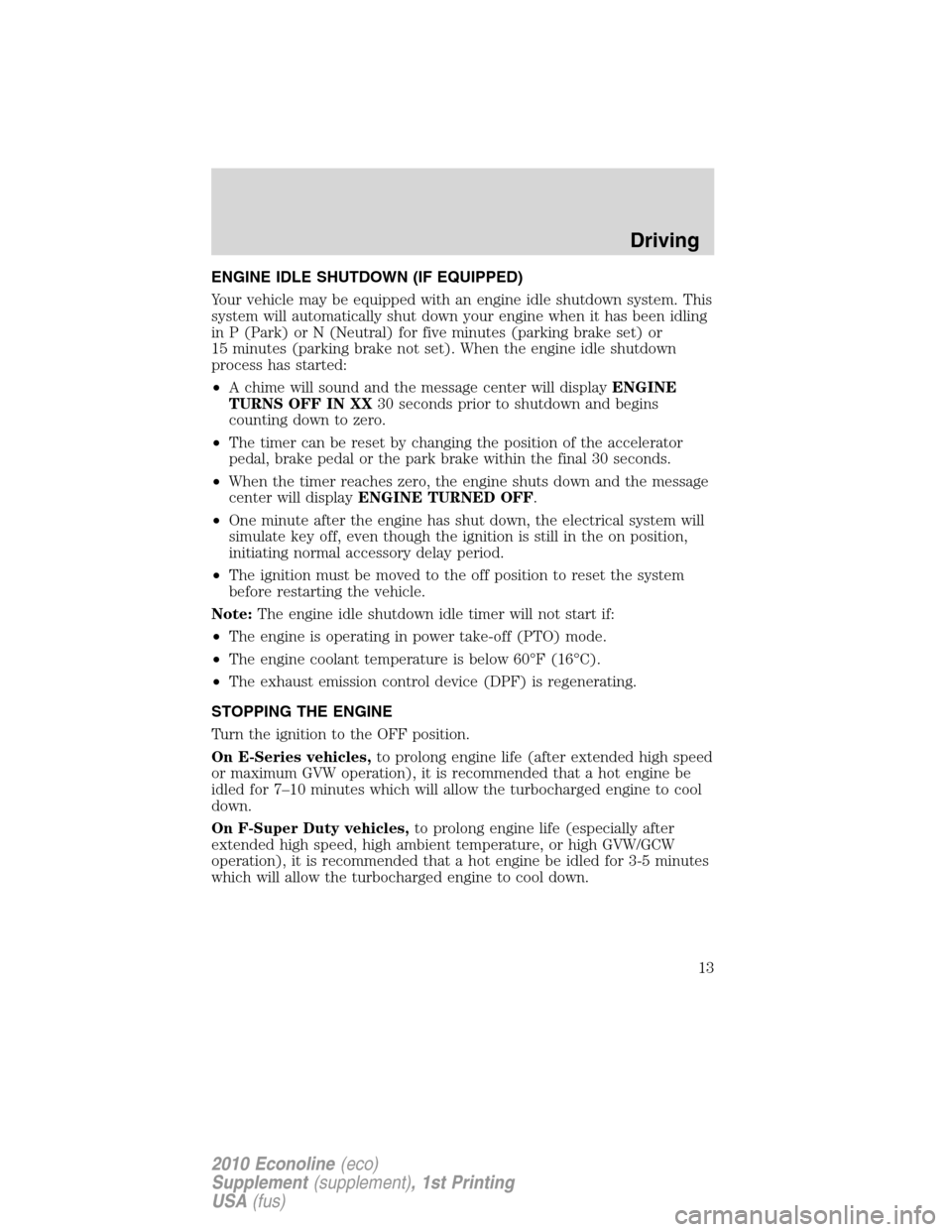
ENGINE IDLE SHUTDOWN (IF EQUIPPED)
Your vehicle may be equipped with an engine idle shutdown system. This
system will automatically shut down your engine when it has been idling
in P (Park) or N (Neutral) for five minutes (parking brake set) or
15 minutes (parking brake not set). When the engine idle shutdown
process has started:
•A chime will sound and the message center will displayENGINE
TURNS OFF IN XX30 seconds prior to shutdown and begins
counting down to zero.
•The timer can be reset by changing the position of the accelerator
pedal, brake pedal or the park brake within the final 30 seconds.
•When the timer reaches zero, the engine shuts down and the message
center will displayENGINE TURNED OFF.
•One minute after the engine has shut down, the electrical system will
simulate key off, even though the ignition is still in the on position,
initiating normal accessory delay period.
•The ignition must be moved to the off position to reset the system
before restarting the vehicle.
Note:The engine idle shutdown idle timer will not start if:
•The engine is operating in power take-off (PTO) mode.
•The engine coolant temperature is below 60°F (16°C).
•The exhaust emission control device (DPF) is regenerating.
STOPPING THE ENGINE
Turn the ignition to the OFF position.
On E-Series vehicles,to prolong engine life (after extended high speed
or maximum GVW operation), it is recommended that a hot engine be
idled for 7–10 minutes which will allow the turbocharged engine to cool
down.
On F-Super Duty vehicles,to prolong engine life (especially after
extended high speed, high ambient temperature, or high GVW/GCW
operation), it is recommended that a hot engine be idled for 3-5 minutes
which will allow the turbocharged engine to cool down.
Driving
13
2010 Econoline(eco)
Supplement(supplement), 1st Printing
USA(fus)
Page 15 of 104
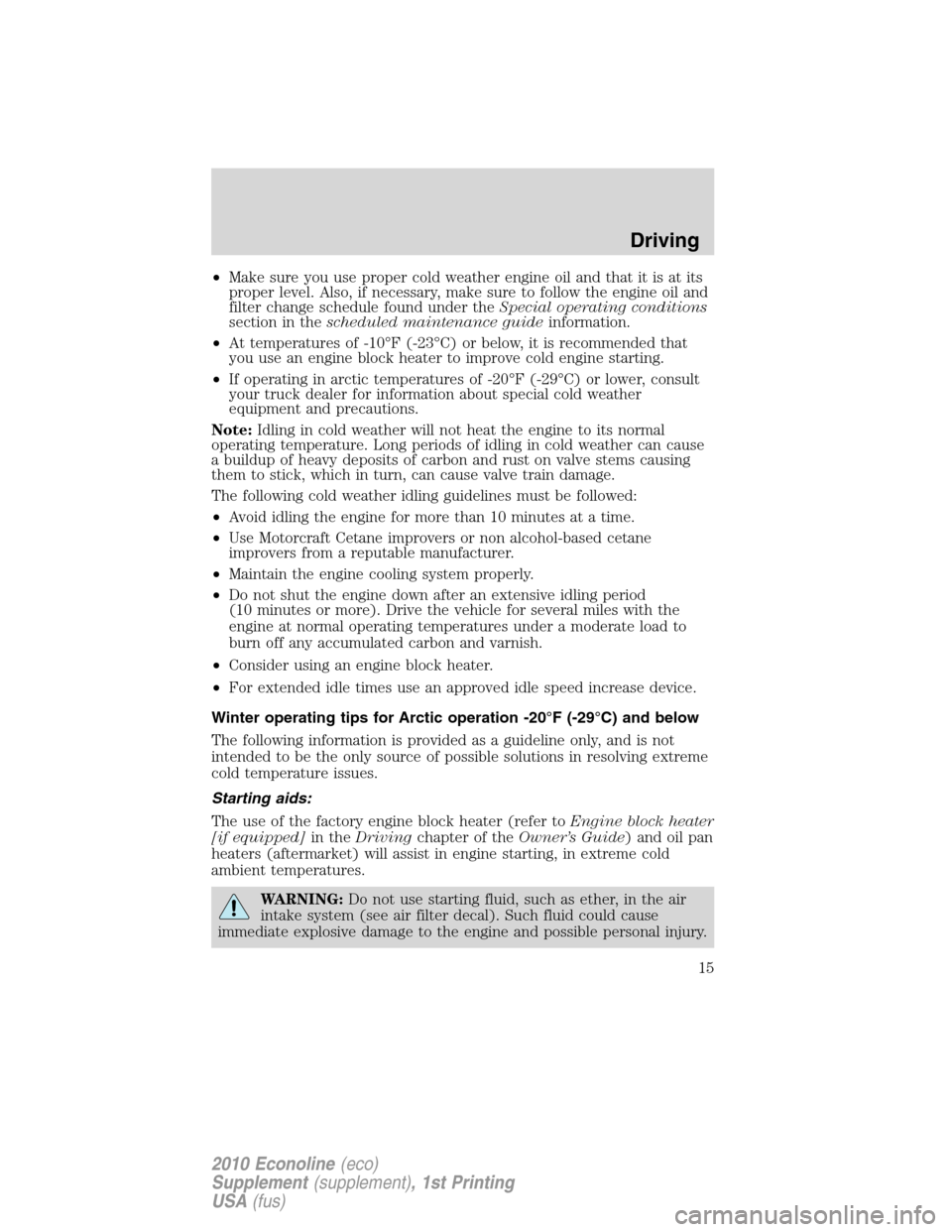
•Make sure you use proper cold weather engine oil and that it is at its
proper level. Also, if necessary, make sure to follow the engine oil and
filter change schedule found under theSpecial operating conditions
section in thescheduled maintenance guideinformation.
•At temperatures of -10°F (-23°C) or below, it is recommended that
you use an engine block heater to improve cold engine starting.
•If operating in arctic temperatures of -20°F (-29°C) or lower, consult
your truck dealer for information about special cold weather
equipment and precautions.
Note:Idling in cold weather will not heat the engine to its normal
operating temperature. Long periods of idling in cold weather can cause
a buildup of heavy deposits of carbon and rust on valve stems causing
them to stick, which in turn, can cause valve train damage.
The following cold weather idling guidelines must be followed:
•Avoid idling the engine for more than 10 minutes at a time.
•Use Motorcraft Cetane improvers or non alcohol-based cetane
improvers from a reputable manufacturer.
•Maintain the engine cooling system properly.
•Do not shut the engine down after an extensive idling period
(10 minutes or more). Drive the vehicle for several miles with the
engine at normal operating temperatures under a moderate load to
burn off any accumulated carbon and varnish.
•Consider using an engine block heater.
•For extended idle times use an approved idle speed increase device.
Winter operating tips for Arctic operation -20°F (-29°C) and below
The following information is provided as a guideline only, and is not
intended to be the only source of possible solutions in resolving extreme
cold temperature issues.
Starting aids:
The use of the factory engine block heater (refer toEngine block heater
[if equipped]in theDrivingchapter of theOwner’s Guide) and oil pan
heaters (aftermarket) will assist in engine starting, in extreme cold
ambient temperatures.
WARNING:Do not use starting fluid, such as ether, in the air
intake system (see air filter decal). Such fluid could cause
immediate explosive damage to the engine and possible personal injury.
Driving
15
2010 Econoline(eco)
Supplement(supplement), 1st Printing
USA(fus)
Page 37 of 104
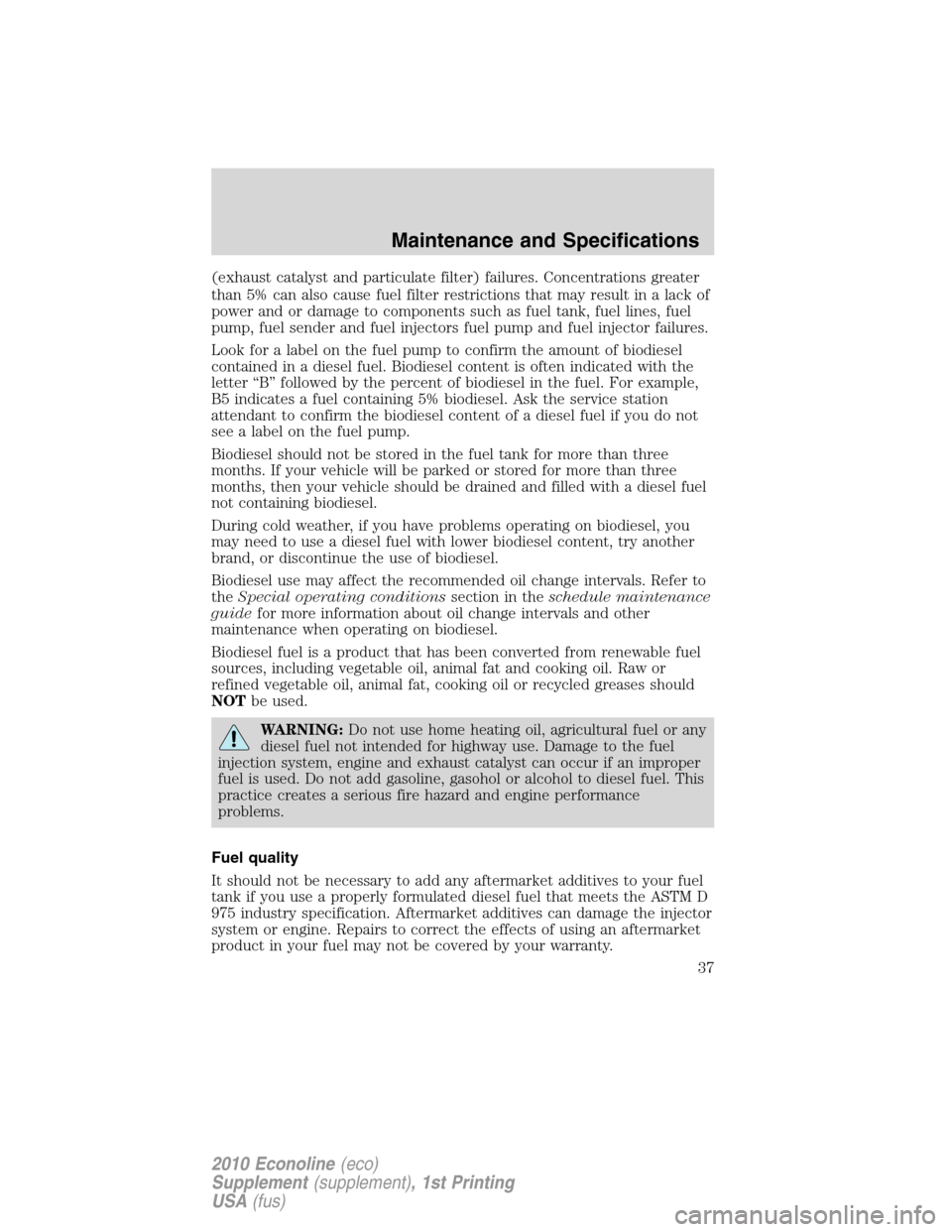
(exhaust catalyst and particulate filter) failures. Concentrations greater
than 5% can also cause fuel filter restrictions that may result in a lack of
power and or damage to components such as fuel tank, fuel lines, fuel
pump, fuel sender and fuel injectors fuel pump and fuel injector failures.
Look for a label on the fuel pump to confirm the amount of biodiesel
contained in a diesel fuel. Biodiesel content is often indicated with the
letter “B” followed by the percent of biodiesel in the fuel. For example,
B5 indicates a fuel containing 5% biodiesel. Ask the service station
attendant to confirm the biodiesel content of a diesel fuel if you do not
see a label on the fuel pump.
Biodiesel should not be stored in the fuel tank for more than three
months. If your vehicle will be parked or stored for more than three
months, then your vehicle should be drained and filled with a diesel fuel
not containing biodiesel.
During cold weather, if you have problems operating on biodiesel, you
may need to use a diesel fuel with lower biodiesel content, try another
brand, or discontinue the use of biodiesel.
Biodiesel use may affect the recommended oil change intervals. Refer to
theSpecial operating conditionssection in theschedule maintenance
guidefor more information about oil change intervals and other
maintenance when operating on biodiesel.
Biodiesel fuel is a product that has been converted from renewable fuel
sources, including vegetable oil, animal fat and cooking oil. Raw or
refined vegetable oil, animal fat, cooking oil or recycled greases should
NOTbe used.
WARNING:Do not use home heating oil, agricultural fuel or any
diesel fuel not intended for highway use. Damage to the fuel
injection system, engine and exhaust catalyst can occur if an improper
fuel is used. Do not add gasoline, gasohol or alcohol to diesel fuel. This
practice creates a serious fire hazard and engine performance
problems.
Fuel quality
It should not be necessary to add any aftermarket additives to your fuel
tank if you use a properly formulated diesel fuel that meets the ASTM D
975 industry specification. Aftermarket additives can damage the injector
system or engine. Repairs to correct the effects of using an aftermarket
product in your fuel may not be covered by your warranty.
Maintenance and Specifications
37
2010 Econoline(eco)
Supplement(supplement), 1st Printing
USA(fus)
Page 61 of 104

SCHEDULED MAINTENANCE GUIDE
Vehicle Identification Number (VIN):
Owner Name:
Address:
Note:Use only a 6.4L diesel engine that has been configured for use with
high sulfur diesel fuel in markets with diesel fuel that has sulfur content
greater than 15 ppm. Using low sulfur diesel fuel (16–500 ppm) or high
sulfur diesel fuel (greater than 500 ppm) in a 6.4L diesel engine designed
to use only Ultra Low Sulfur Diesel fuel increases the likelihood of engine
oil dilution with fuel which may lead to major engine damage. Vehicles
that are operated in high sulfur diesel fuel markets must be configured
for the high sulfur fuel and require a different maintenance schedule.
*SeeSpecial Operating Conditionsin theScheduled Maintenance:
F-Super Dutychapter
GENERAL MAINTENANCE INFORMATION
Why maintain your vehicle?
This guide describes the scheduled maintenance required for your
vehicle. Carefully following this schedule helps protect against major
repair expenses resulting from neglect or inadequate maintenance and
may also help to increase the value of your vehicle when you sell or
trade it.
It is your responsibility to see that all scheduled maintenance is
performed and that the materials used meet Ford engineering
specifications. Failure to perform scheduled maintenance in this guide
will invalidate warranty coverage on parts affected by the lack of
maintenance. Be sure receipts for completed maintenance are kept with
the vehicle and confirmation of the work performed is always recorded in
this guide.
Scheduled Maintenance: General Information
61
2010 Econoline(eco)
Supplement(supplement), 1st Printing
USA(fus)
Page 62 of 104

Your Ford dealer, or Ford Quality Care Center has factory trained
technicians who can perform the required maintenance using genuine
Ford parts. They are committed to meeting your service needs and to
assuring your continuing satisfaction.
Protecting your investment
Maintenance is an investment that will pay dividends in the form of
improved reliability, durability and resale value. To ensure the proper
performance of your vehicle and its emission control systems, it is
imperative that scheduled maintenance be completed at the designated
intervals.
Your vehicle is very sophisticated and built with multiple complex
performance systems. Every manufacturer develops these systems using
different specifications and performance features. That’s why it’s
important to rely upon your Ford dealership to properly diagnose and
repair your vehicle.
Ford Motor Company has recommended maintenance intervals for
various parts and component systems based upon engineering testing.
Ford Motor Company relies upon this testing to determine the most
appropriate mileage for replacement of oils and fluids to protect your
vehicle at the lowest overall cost to you and recommends against
maintenance schedules that deviate from the scheduled maintenance
information.
Ford strongly recommends the use of genuine Ford replacement parts.
Parts other than Ford, Motorcraft or Ford authorized remanufactured
parts that are used for maintenance replacement or for the service of
components affecting emission control must be equivalent to genuine
Ford Motor Company parts in performance and durability. It is the
owner’s responsibility to determine the equivalency of such parts. Please
consult yourCustomer Information Guidefor complete warranty
information.
Non-Ford approved chemicals or additives are not required for factory
recommended maintenance. In fact, Ford Motor Company recommends
against the use of such additive products unless specifically
recommended by Ford for a particular application.
Oils, Fluids and Flushing
In many cases, fluid discoloration is a normal operating characteristic of
the chemical compound and may not necessarily demonstrate that a fluid
needs to be changed. Oils and fluids identified in this guide should be
changed at the specified interval or in conjunction with a repair. Flushing
Scheduled Maintenance: General Information
62
2010 Econoline(eco)
Supplement(supplement), 1st Printing
USA(fus)
Page 65 of 104
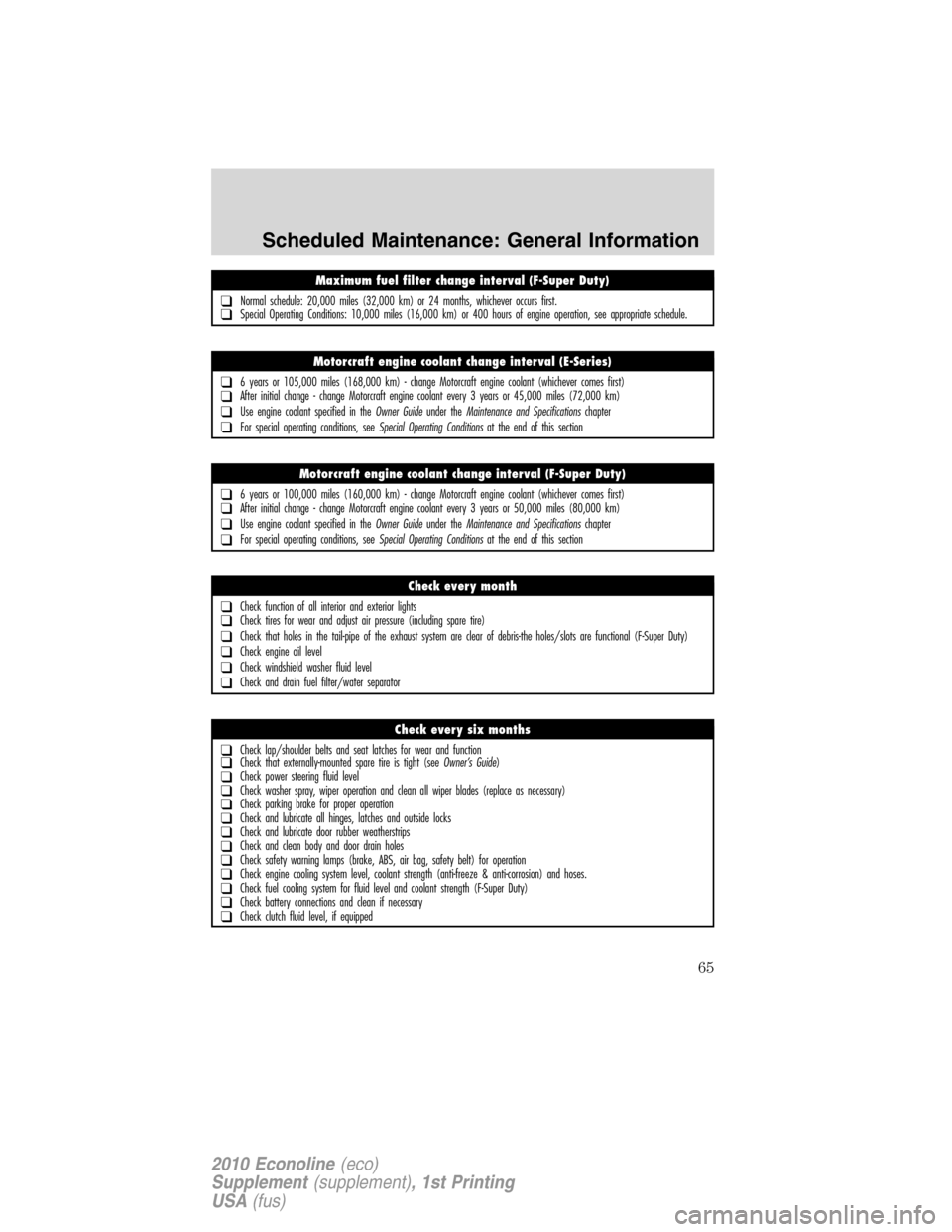
Maximum fuel filter change interval (F-Super Duty)
❑Normal schedule: 20,000 miles (32,000 km) or 24 months, whichever occurs first.❑Special Operating Conditions: 10,000 miles (16,000 km) or 400 hours of engine operation, see appropriate schedule.
Motorcraft engine coolant change interval (E-Series)
❑6 years or 105,000 miles (168,000 km) - change Motorcraft engine coolant (whichever comes first)❑After initial change - change Motorcraft engine coolant every 3 years or 45,000 miles (72,000 km)
❑Use engine coolant specified in theOwner Guideunder theMaintenance and Specificationschapter
❑For special operating conditions, seeSpecial Operating Conditionsat the end of this section
Motorcraft engine coolant change interval (F-Super Duty)
❑6 years or 100,000 miles (160,000 km) - change Motorcraft engine coolant (whichever comes first)❑After initial change - change Motorcraft engine coolant every 3 years or 50,000 miles (80,000 km)
❑Use engine coolant specified in theOwner Guideunder theMaintenance and Specificationschapter
❑For special operating conditions, seeSpecial Operating Conditionsat the end of this section
Check every month
❑Check function of all interior and exterior lights❑Check tires for wear and adjust air pressure (including spare tire)
❑Check that holes in the tail-pipe of the exhaust system are clear of debris-the holes/slots are functional (F-Super Duty)
❑Check engine oil level
❑Check windshield washer fluid level
❑Check and drain fuel filter/water separator
Check every six months
❑Check lap/shoulder belts and seat latches for wear and function❑Check that externally-mounted spare tire is tight (seeOwner’s Guide)❑Check power steering fluid level❑Check washer spray, wiper operation and clean all wiper blades (replace as necessary)❑Check parking brake for proper operation❑Check and lubricate all hinges, latches and outside locks❑Check and lubricate door rubber weatherstrips❑Check and clean body and door drain holes❑Check safety warning lamps (brake, ABS, air bag, safety belt) for operation❑Check engine cooling system level, coolant strength (anti-freeze & anti-corrosion) and hoses.❑Check fuel cooling system for fluid level and coolant strength (F-Super Duty)❑Check battery connections and clean if necessary❑Check clutch fluid level, if equipped
Scheduled Maintenance: General Information
65
2010 Econoline(eco)
Supplement(supplement), 1st Printing
USA(fus)
Page 102 of 104
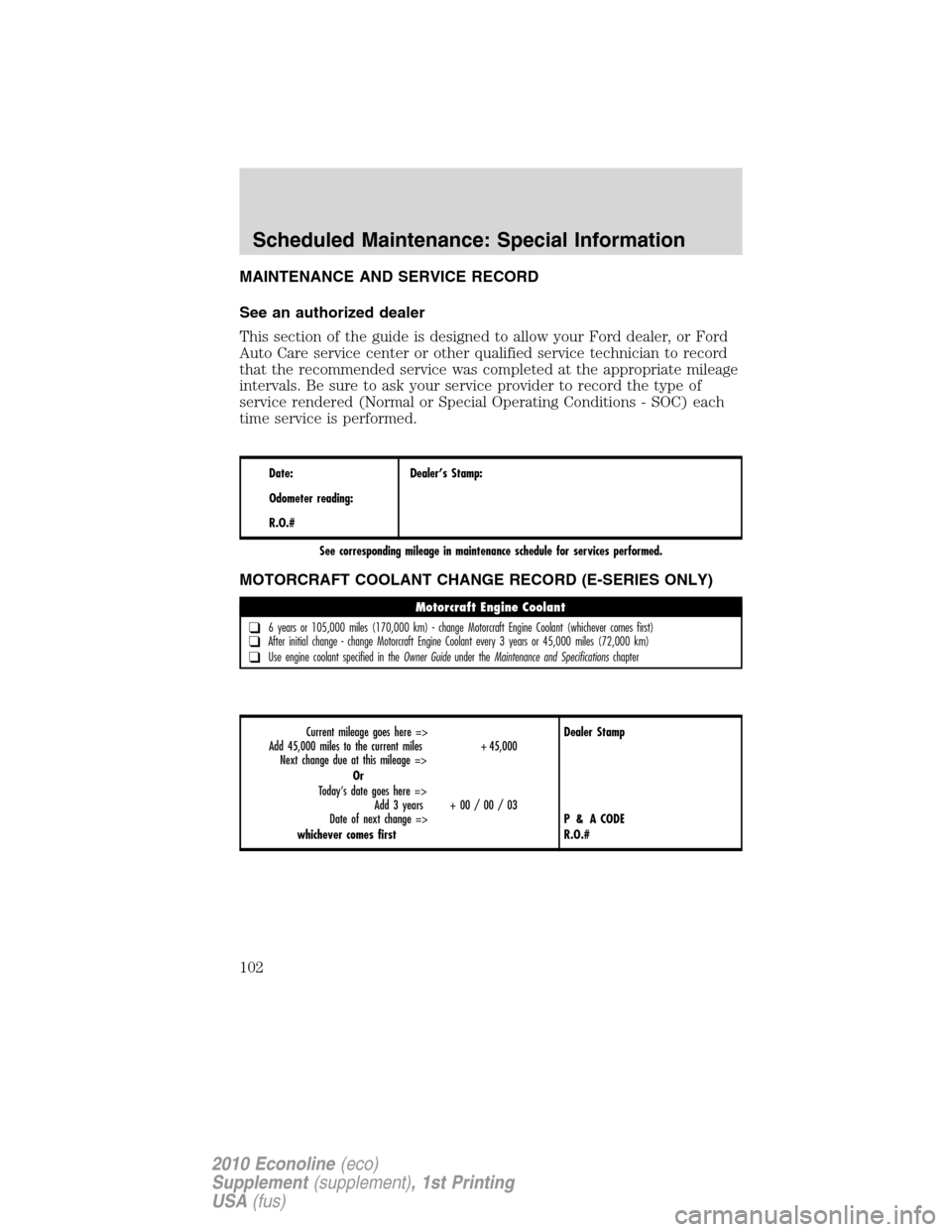
MAINTENANCE AND SERVICE RECORD
See an authorized dealer
This section of the guide is designed to allow your Ford dealer, or Ford
Auto Care service center or other qualified service technician to record
that the recommended service was completed at the appropriate mileage
intervals. Be sure to ask your service provider to record the type of
service rendered (Normal or Special Operating Conditions - SOC) each
time service is performed.
Date:
Odometer reading:
R.O.#Dealer’s Stamp:
See corresponding mileage in maintenance schedule for services performed.
MOTORCRAFT COOLANT CHANGE RECORD (E-SERIES ONLY)
Current mileage goes here =>
Add 45,000 miles to the current miles + 45,000
Next change due at this mileage =>
Or
Today’s date goes here =>
Add 3 years + 00 / 00 / 03
Date of next change =>
whichever comes firstDealer Stamp
P & A CODE
R.O.#
Motorcraft Engine Coolant
❑6 years or 105,000 miles (170,000 km) - change Motorcraft Engine Coolant (whichever comes first)❑After initial change - change Motorcraft Engine Coolant every 3 years or 45,000 miles (72,000 km)
❑Use engine coolant specified in theOwner Guideunder theMaintenance and Specificationschapter
Scheduled Maintenance: Special Information
102
2010 Econoline(eco)
Supplement(supplement), 1st Printing
USA(fus)